Changes in Relative Importance
of Transport Modes
(Domestic Cargo Transport: Ton-Km basis)
| 4. In particular, private cars and trucks became more popular to the point where they changed the shape of demand place on public transport such as railway and buses although the effect differed depending on the field of transport and region. Passenger transport had a great effect on Region Areas1, which saw the inevitable shrinking of part of public transport including buses. However, mobility on the whole was improved through the use of private cars that were superior in convenience. In contrast, in the heavy populated Urban Areas1, railway and bus transport have continued to fulfill the main mode of transportation for people commuting to work or school. In Japan's three largest cities, in particular, railway transport has functioned as the main mode of transport. As a result, in comparison to other advanced nations, the unit amount of CO2 gas emissions per unit transport volumes lower meaning that a low environment-burden transport system has been formed |
International Comparison of the Relative Importance of Modes of Transport Used to Commute to Work |
Regional Bus Lines |
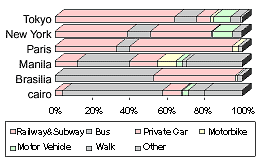 |
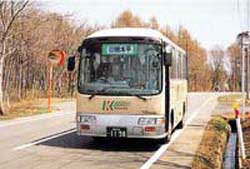 |
|
| Source : Ministry of Transport "1999 Transport White Paper" |
| Changes in Relative Importance of Transport
Modes (Domestic Passenger Transport: Person-Km basis) |
|
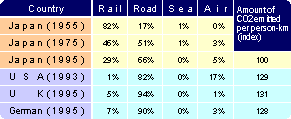 |
Notes: 1) Light motor vehicles mode of transportation is not included in road numbers for Japan in 1955 or 1975. 2) The unit used for the amount of CO2 emitted in each mode of transportation in Japan and other countries was the same. |
| Changes in Relative Importance of Domestic Passenger Transport | Changes in Relative Importance of Domestic Cargo Transport |
 |
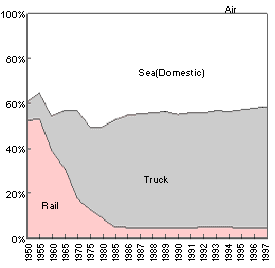 |
||
| NB: light motor vehicles have been included in private car numbers from 1987 onward Source: This graph was created using "Land Transport Statistics Directory" and "the Motor Transportation Annual Statistics Report" from the Ministry of Transport |
|||
| As the reliance on trucks with their superior convenience continues to expand along with the development of sea transport of large quantity cargo due to the geographical characteristics of the coastal industrial region in the field of distribution, the share, which in the past was over half of all domestic cargo transport, of rail is dramatically decreasing. As a result, the environmental impact from the perspective of the amount of CO2 gas emitted has now been brought down to the same level as many Western countries. In comparison to the American, in which the large land mass has seen rail cargo develop, the affect is large. |
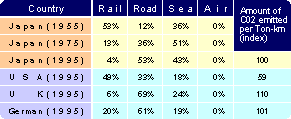 |
|
Notes: 1) Light motor vehicles mode of transportation is not included in road numbers for Japan in 1955 or 1975. Furthermore, in foreign countries there are also pipelines, however they have been excluded from this chart. 2) The unit used for the amount of CO2 emitted in each mode of transportation in Japan and other countries was the same. |
|
|
PREVIOUS |
|
TOP |
|